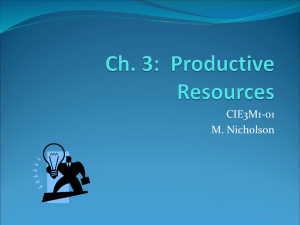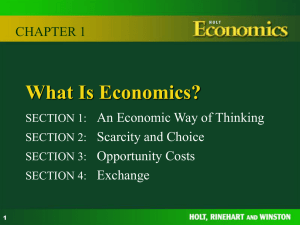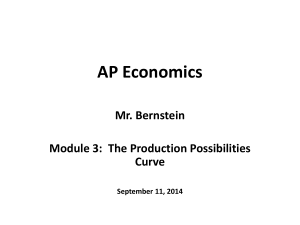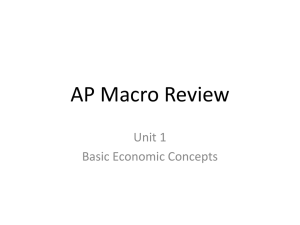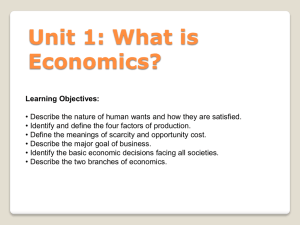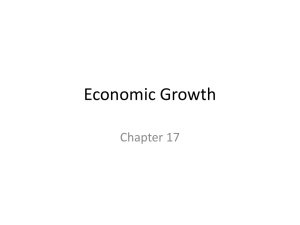Introduction to Economics and Scarcity
advertisement
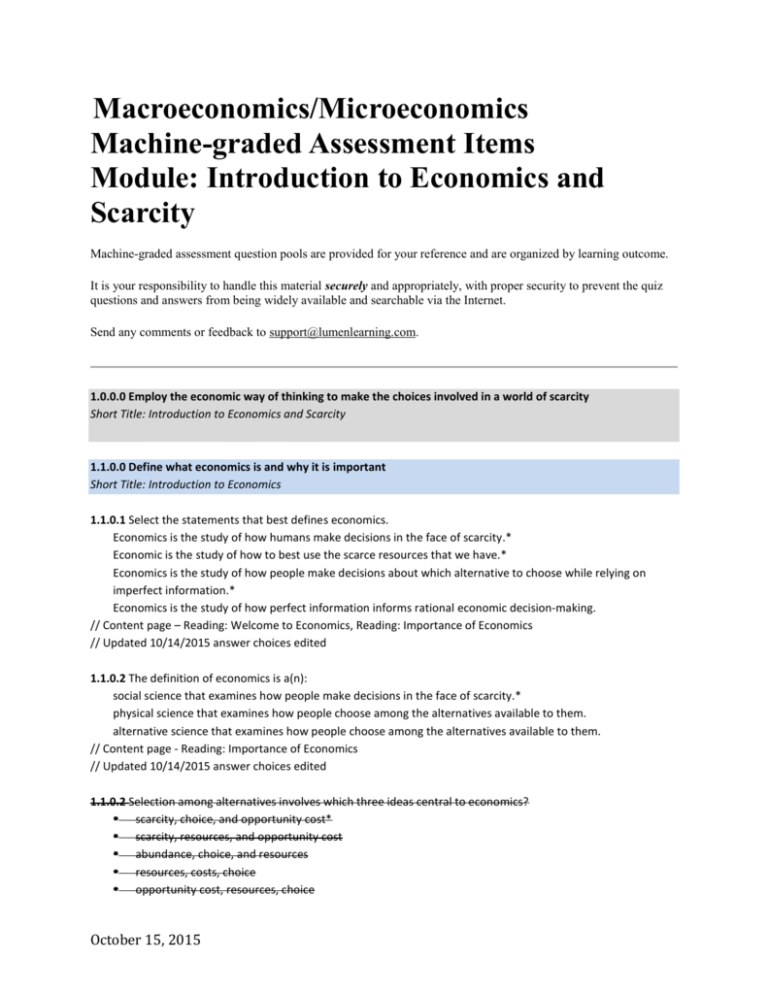
Macroeconomics/Microeconomics Machine-graded Assessment Items Module: Introduction to Economics and Scarcity Machine-graded assessment question pools are provided for your reference and are organized by learning outcome. It is your responsibility to handle this material securely and appropriately, with proper security to prevent the quiz questions and answers from being widely available and searchable via the Internet. Send any comments or feedback to support@lumenlearning.com. 1.0.0.0 Employ the economic way of thinking to make the choices involved in a world of scarcity Short Title: Introduction to Economics and Scarcity 1.1.0.0 Define what economics is and why it is important Short Title: Introduction to Economics 1.1.0.1 Select the statements that best defines economics. Economics is the study of how humans make decisions in the face of scarcity.* Economic is the study of how to best use the scarce resources that we have.* Economics is the study of how people make decisions about which alternative to choose while relying on imperfect information.* Economics is the study of how perfect information informs rational economic decision-making. // Content page – Reading: Welcome to Economics, Reading: Importance of Economics // Updated 10/14/2015 answer choices edited 1.1.0.2 The definition of economics is a(n): social science that examines how people make decisions in the face of scarcity.* physical science that examines how people choose among the alternatives available to them. alternative science that examines how people choose among the alternatives available to them. // Content page - Reading: Importance of Economics // Updated 10/14/2015 answer choices edited 1.1.0.2 Selection among alternatives involves which three ideas central to economics? scarcity, choice, and opportunity cost* scarcity, resources, and opportunity cost abundance, choice, and resources resources, costs, choice opportunity cost, resources, choice October 15, 2015 // Removed 10/14/2015 In economics, scarcity means: human wants for goods and services exceed what is available.* there are only 24 hours in a day.* reasonable people limit their wants to what is available. // Content page – Reading: Importance of Economics // New 10/14/2015 1.1.a.0 Define scarcity Short Title: Scarcity 1.1.a.1 The economic term “scarcity” is best defined as which of the following? Human wants exceed the available supply.* There is limited supply of workers.* The workforce has low productivity. // Content page – Reading: Importance of Economics // Updated 10/14/2015 answer choices edited 1.1.a.2 Why is there scarcity? Because the opportunity set determines this. Because theory dictates it. Because our unlimited wants exceed our limited resources* Because human wants are limited. // Content page – Reading: Importance of Economics 1.1.a.3 Scarcity implies that: consumers would be willing to purchase the same quantity of a good at a higher price. it is impossible to completely fulfill the unlimited human desire for goods and services with the limited resources available.* at the current market price, consumers are willing to purchase more of a good than suppliers are willing to produce. consumers are too poor to afford the goods and services available. // Content page – Reading: Importance of Economics 1.1.a.4 The economic term “scarcity” is best defined as which of the following? A social problem that results from poverty. Low productivity of the labor force. Limited natural resources.* // Content page – Reading: Importance of Economics // Updated 10/14/2015 answer choices edited Which of the following best describes the division of labor: a single production process can be subdivided into specialized tasks.* the loss in productivity that occurs when a single job is broken down into smaller tasks. a strategy that allows workers to specialize in the tasks in which they are most skilled.* October 15, 2015 // Content page - Reading: Division and Specialization of Labor // New 10/14/2015 The specialization of labor describes: a strategy that works best when workers specialized in producing one good can spend their income on other goods.* the loss in productivity that occurs when a single job is broken down into many smaller tasks. when individuals focus on one part of the production they learn to do it quickly and with higher quality.* // Content page - Reading: Division and Specialization of Labor // New 10/14/2015 Microeconomics includes the study of: the purchasing habits of a middle-income household.* the national unemployment rate. inflation. the pricing strategy of a local business.* // Content page - Reading: Macroeconomics and Microeconomics // New 10/14/2015 Macroeconomics includes the study of: the unemployment rate.* the balance of trade.* consumer demand for electronics. inflation.* // Content page - Reading: Macroeconomics and Microeconomics // New 10/14/2015 Monetary policy involves_____________________ and fiscal policy involves ___________________. policies that affect bank lending and interest rates : government spending and taxes* the Federal Reserve : U.S. Congress* government spending and taxes : policies that affect bank lending and interest rates // Content page - Reading: Macroeconomics and Microeconomics // New 10/14/2015 1.2.0.0 Recognize the concept of opportunity cost, and differentiate it from monetary cost Short Title: Opportunity Cost 1.2.0.1 One of the most important concepts in all of economics is opportunity cost. Identify the statements that help define this concept. Opportunity cost is the value of the best alternative forgone in making a choice.* Opportunity cost is the price of something. It is the same thing as purchase price. Opportunity cost is the consumer’s perception of value for something. It is the amount you believe something is worth and are willing to pay. // Content page – Reading: The Concept of Opportunity Cost October 15, 2015 1.2.0.2 The real economic cost of a good or service produced when measured by the value of the sacrificed alternative is the what? opportunity cost* real cost money cost sunk cost // Content page – Reading: The Concept of Opportunity Cost 1.2.0.3 The opportunity cost of any choice is best described as: the value of the best alternative that had to be given up in making that choice.* the cost of some other item that you could have purchased. a measure of how scarce an item is. the sum of all the alternatives given up in making a particular decision. // Content page – Reading: The Concept of Opportunity Cost // Updated 10/14/2015 question and answer choices edited 1.2.0.4 In economics, every choice always has: an opportunity cost.* a value based on the best foregone alternative.* negative consequences. // Content page – Reading: The Concept of Opportunity Cost // Updated 10/14/2015 question and answer choices edited Opportunity cost is best defined as: All of the possible alternatives given up. The value of the next best alternative that is given up in making a choice.* The amount of money spent in consuming something. The amount of time and money spent in consuming something. // Content page – Reading: The Concept of Opportunity Cost // Relocated from enabling outcome “Law of Increasing Opportunity Cost” 10/14/2015 Suppose you make the decision to volunteer for an event in school for an hour this week. This means that you would have to take an hour off from your summer job, for which you earn $10 per hour. You spend $3 in bus fare in order to get to school and $5 for lunch. If you went to work, you would have been able to walk to your job, and lunch would have been provided to you by the office. The opportunity cost of volunteering is: $8 $2 $18* $10 // Content page – Reading: The Concept of Opportunity Cost // Relocated from enabling outcome “Law of Increasing Opportunity Cost” 10/14/2015 Which of the following best defines and values opportunity cost? Opportunity cost is the value of the next best alternative that is given up in making a choice; it is the same for each person. October 15, 2015 Opportunity cost is the value of the next best alternative that is given up in making a choice; it can be different for each person.* Opportunity cost is the explicit dollar value of the next best alternative that is given up in making a choice; it is the same for each person. Opportunity cost is the explicit dollar value of the next best alternative that is given up in making a choice; it can be different for each person. // Content page – Reading: The Concept of Opportunity Cost // Relocated from enabling outcome “Law of Increasing Opportunity Cost” 10/14/2015 1.2.a.0 Calculate the opportunity costs of an action Short Title: Calculating Opportunity Cost 1.2.a.1 Gomer decides to spend an hour playing basketball rather than studying. His opportunity cost is: nothing, because he enjoys playing basketball more than studying. the increase in skill he obtains from playing basketball for that hour. the benefit to his grades from studying for an hour.* nothing, because he had a free pass into the sports complex to play basketball. // Content page – Reading: The Concept of Opportunity Cost 1.2.a.2 “If I didn’t have class tonight, I would save the $4 campus parking fee and spend four hours at work where I earn $10 per hour.” The opportunity cost of attending class this evening is: $0 $4 $40 $44* // Content page – Reading: The Concept of Opportunity Cost 1.2.a.3 A student has only a few hours to prepare for two different exams this afternoon. The table below shows alternative possible exam scores with three alternative uses of the student’s time. The opportunity cost of scoring a 94 on the economics exam rather than a 77 is: Possibility A Economics History I 94 76 II 87 84 III 77 91 8 points on the history exam. 15 points on the history exam.* 14 points on the history exam. 17 points on the history exam. // Content page – Reading: The Concept of Opportunity Cost 1.2.a.4 A student has only a few hours to prepare for two different exams tomorrow morning. The table below shows alternative possible exam outcomes with three alternative uses of the student’s time. The opportunity cost of scoring an 84 on the history exam rather than 76 is: October 15, 2015 Possibility A Economics History I 94 76 II 87 84 III 77 91 10 points on the economics exam. 8 points on the history exam. 7 points on the economics exam.* 12 points on the economics exam. // Content page – Reading: The Concept of Opportunity Cost 1.2.b.0 Represent basic economic models using graphing tools Short Title: Graphs in Economics 1.2.b.1 The change in the vertical axis divided by the change in the horizontal axis is known as the: slope.* y-intercept. run. ratio. // Content page – Reading: The Concept of Opportunity Cost (see link to “The Use of Mathematics in Principles of Economics”) 1.2.b.2 A ________ is something whose value can change. variable* constant hypothesis slippery slope shift // Content page – Reading: The Concept of Opportunity Cost (see link to “The Use of Mathematics in Principles of Economics”) 1.2.b.3 A slope on a standard graph between two variables always measures ______________. the relationship between the two variables* scientific cause and effect a constant correlation between the variables the differences between two variables // Content page – Reading: The Concept of Opportunity Cost (see link to “The Use of Mathematics in Principles of Economics”) 1.3.0.0 Define society’s tradeoffs through the use of the production possibilities frontier (or curve) Short Title: The Production Possibilities Frontier 1.3.0.1 The maximum combinations of two outputs that could be produced with available resources is represented on a graph by which of the following? October 15, 2015 production possibility frontier* maximization of resources opportunity cost Gross Domestic Product production efficiency curve // Content page - Reading: The Production Possibilities Frontier 1.3.0.2 A Production Possibility Curve demonstrates: all combinations of two goods that are efficient to produce.* the law of diminishing returns.* the efficiency of labor, investment in capital, and the reduction of scarcity. // Content page - Reading: The Production Possibilities Frontier, Reading: Productive Efficiency and Allocative Efficiency // Updated 10/14/2015 answer choices edited 1.3.0.3 When one country is able to produce the same good as another country but at a lower opportunity cost, the first country is said to have ________ in that good. a comparative advantage* a technological superiority an absolute advantage comparative monopoly // Content page - Reading: Productive Efficiency and Allocative Efficiency 1.3.0.4 A Production Possibility Curve shows an economy’s greatest: potential for producing two different goods.* level of employment. most efficient use of the factors of production.* possible level of production without technological restraints. // Content page - Reading: The Production Possibilities Frontier // Updated 10/14/2015 scoring corrected 1.3.0.5 An economy will have a comparative advantage if its ________. opportunity cost is lower than that of another country* production is higher in the economy costs are the least expensive technology is efficient // Content page - Reading: Productive Efficiency and Allocative Efficiency 1.3.0.6 The production possibilities curve represents the maximum combination of future products which can be produced with maximum growth in resources the maximum combination of products which can be produced with fixed technology and resources* the maximum combination of products which can be produced if prices decline // Removed 10/14/2015 Which of these is an example of diminishing marginal returns on a production possibility frontier that describes the production of apples and oranges? October 15, 2015 Gains to producing an additional apple depends on how many oranges are being already produced.* Gains to producing an additional apple is greater the larger a large number of apples are already being produced. Gains to producing an additional orange is greater when a larger number of apples are already being produced.* // Content page - Reading: The Production Possibilities Frontier // New 10/14/2015 1.3.a.0 Construct a production possibilities frontier given a dataset of production alternatives Short Title: Constructing a Production Possibilities Frontier 1.3.a.1 The production possibilities schedule below shows the hypothetical relationship between the production of industrial robots and food. Refer to the table below. The marginal opportunity cost of the second unit of industrial robots is: Products A B C D E Industrial Robots 0 1 2 3 4 Food 100 90 70 40 0 20 units of food* 70 units of food 35 units of food // Removed 10/14/2015 The absolute value of the slope of the production possibilities curve shows the: amount of the good on the horizontal axis that must be given up to produce an additional unit of the good on the vertical axis. amount of the good on the vertical axis that must be given up to produce an additional unit of the good on the horizontal axis.* opportunity cost of producing an additional unit of the good on the horizontal axis.* // Content page – Reading: The Production Possibilities Curve // New 10/14/2015 1.3.a.2 The production possibilities schedule below shows the hypothetical relationship between the production of industrial robots and food. In moving from production alternative D to C, Products A B C D E Industrial Robots 0 1 2 3 4 Food 100 90 70 40 0 2 units of industrial robots are given up to get 70 units of food 1 unit of industrial robots are given up to get 30 units of food* 30 units of food are given up to get 1 unit of industrial robots // Removed 10/14/2015 October 15, 2015 The production possibilities curve describes the: mix of goods that are economically most efficient to produce.* opportunity cost of producing more of one good in terms of the other good.* mix of goods that society is most willing to purchase. // Content page – Reading: The Production Possibilities Curve // New 10/14/2015 1.3.a.3 The production possibilities schedule below shows the hypothetical relationship between the production of industrial robots and food. If an economy produces 2 units of industrial robots and 60 units of food, the economy is likely experiencing: Products A B C D E Industrial Robots 0 1 2 3 4 Food 100 90 70 40 0 an increase in the opportunity cost of food a reduction in the amount of capital stock underemployment of one or more of its resources* // Content page – Reading: The Production Possibilities Curve // Updated 10/14/2015 answer choice edited 1.3.b.0 Explain verbally and demonstrate graphically why opportunity costs increase (The Law of Increasing Opportunity Cost) Short Title: Law of Increasing Opportunity Cost 1.3.b.1 Identify the explanation(s) that accurately describe the Law of Increasing Opportunity Cost. As an economy moves along its production possibilities curve in the direction of producing more of a particular good, the opportunity cost of additional units of that good will increase.* Assume you have a company that makes cups and then starts to make plates also. At first the opportunity cost of plates will be relatively low, but as the company makes more plates the opportunity cost per plate will increase.* Opportunity cost increases as a result of inflation. As inflation rises, the opportunity cost rises proportionally. For example, in a factory that produces just one type of product, opportunity cost rises in step with direct costs. // Content page – Reading: The Production Possibilities Curve // Updated 10/14/2015 question edited 1.3.b.2 Why do opportunity costs increase more as the production of a good increases? It is because there is less and less efficiency in producing.* It is because of environmental restraints and limitations. It is because the price of alternative goods rises. // Content page – Reading: Productive Efficiency and Allocative Efficiency 1.3.b.3 The steeper the slope on the production possibilities curve, the ________. October 15, 2015 greater the opportunity cost* smaller the opportunity cost cheaper the price // Content page – Reading: The Production Possibilities Curve // Content page – Reading: Productive Efficiency and Allocative Efficiency 1.3.b.4 Opportunity cost is best defined as: All of the possible alternatives given up. The value of the next best alternative that is given up in making a choice.* The amount of money spent in consuming something. The amount of time and money spent in consuming something. // Relocated to enabling outcome “Opportunity Costs” 1.3.b.5 Suppose you make the decision to volunteer for an event in school for an hour this week. This means that you would have to take an hour off from your summer job, for which you earn $10 per hour. You spend $3 in bus fare in order to get to school and $5 for lunch. If you went to work, you would have been able to walk to your job, and lunch would have been provided to you by the office. The opportunity cost of volunteering is: $8 $2 $18* $10 // Relocated to enabling outcome “Opportunity Costs” 1.3.b.6 Which of the following best defines and values opportunity cost? Opportunity cost is the value of the next best alternative that is given up in making a choice; it is the same for each person. Opportunity cost is the value of the next best alternative that is given up in making a choice; it can be different for each person.* Opportunity cost is the explicit dollar value of the next best alternative that is given up in making a choice; it is the same for each person. Opportunity cost is the explicit dollar value of the next best alternative that is given up in making a choice; it can be different for each person. // Relocated to enabling outcome “Opportunity Costs” 1.3.b.7 Refer to the diagram below. The production possibilities curve is bowed outward from the origin because: October 15, 2015 (img: https://s3-us-west-2.amazonaws.com/oerfiles/Assessments/economics/autos-tractors.png) the labor force is increasing of the law of diminishing marginal returns* opportunity costs are increasing* // Content page – Reading: The Production Possibilities Curve // Updated 10/14/2015 scoring corrected 1.3.b.8 If a production possibilities curve bows outward from the origin and is not a straight line: the two products do not have the same value to the economy. resources are not equally suited to producing alternative products.* more of one product cannot be produced without producing less of another. // Content page – Reading: The Production Possibilities Curve 1.3.b.9 The Law of Increasing Opportunity Costs is demonstrated by: a production possibilities curve that is bowed out from the origin.* a rightward shift of the production possibilities curve. any inefficient point of production. // Content page – Reading: The Production Possibilities Curve 1.3.c.0 Identify the consequences of underutilization of society’s resources Short Title: Underutilization of Society’s Resources 1.3.c.1 Suppose an economy produces either bread or butter. Which of the following factors might cause the economy to operate at a point inside its production possibilities curve? The butter factory employs 40 people, when it could easily employ 45.* The government designates 100 available land acres as parkland, which could have been used as farmland for growing more wheat.* The economy has achieved full employment. There is a high unemployment* // Content page – Reading: The Production Possibilities Curve 1.3.c.2 An economy operating INSIDE its production possibilities curve: implies that the economy is operating inefficiently* October 15, 2015 implies that the economy is operating at full capacity explains that an economy is producing more than it can use // Content page – Reading: The Production Possibilities Curve 1.3.c.3 Specialization among many workers is preferred over each worker producing the entire good alone because it results in: greater production and lower costs.* more people employed. greater job satisfaction. empowered employees. // Content page – Reading: The Production Possibilities Curve 1.3.c.4 A consultant works for $200 per hour. She likes to eat vegetables, but is not very good growing them. Why does it make more economic sense for her to spend her time at the consulting job and shop for her vegetables instead of growing them herself? She maximizes her income by spending more time consulting, which allows her to consume more vegetables than if she grew them herself.* She maximizes her income by shopping for vegetables at cheaper prices than she could grow them herself. She maximizes her income by consulting part-time and growing some vegetables part-time, and shops for the other vegetables. // Content page – Reading: The Production Possibilities Curve 1.3.c.5 Refer to the diagram below. A point on the production possibilities curve is: (img: https://s3-us-west-2.amazonaws.com/oerfiles/Assessments/economics/autos-tractors.png) attainable and the economy is efficient.* attainable with increased capital investment. unattainable without an increase in technology. // Content page – Reading: The Production Possibilities Curve 1.3.d.0 Identify the necessary conditions for expansion of society’s production possibilities and the resulting consequences of that expansion Short Title: Expansion of Society’s Production Possibilities October 15, 2015 1.3.d.1 An outward shift of the production possibilities curve represents: increasing opportunity costs. increased supply of productive resources.* diminishing opportunity costs. // Removed 10/14/2015 A description of the Great Depression using a production possibilities frontier would show a: movement along the curve toward greater production of necessities and less production of luxuries. location outside the curve as a result of an increased work effort by laborers. location inside the curve as a result of the underemployment of the work force.* // Content page – Reading: The Production Possibilities Curve // New 10/14/2015 1.3.d.2 Technological improvement results in a(n) increase in opportunity costs shift outward of the production possibilities curve* increase in the slope of a production possibilities curve // Removed 10/14/2015 An increase in the supply of labor in an economy can be described in a production possibilities frontier as a(n): movement along the original curve toward greater production of goods that consumers like to purchase. outward shift in the curve because more goods can now be produced with the additional workers.* location inside the original curve as a result of the new additions to the work force. // Content page – Reading: The Production Possibilities Curve // New 10/14/2015 1.3.d.3 If an economy devotes more resources to capital goods and fewer resources to consumer goods, the economy will attain full employment but not full production attain full production but not full employment achieve greater economic growth* // Removed 10/14/2015 If an economy devotes more resources to producing capital goods and fewer resources to producing consumer goods, the economy will: have lower opportunity costs of producing additional consumer goods.* have higher opportunity costs of producing additional consumer goods. experience diminishing marginal returns from producing more capital goods.* // Content page – Reading: The Production Possibilities Curve // New 10/14/2015 1.4.0.0 Explain how economic models are used by economists Short Title: Economic Models October 15, 2015 1.4.0.1 Visual models are based on observations and economic reasoning. The relationship between energy production and air purity have a (an) ________ rather than a (an) ________ relationship. 1. inverse : direct* 1. direct : inverse 1. there is no relationship // Removed 10/14/2015 An economic theory: is based on assumptions about human behavior.* describes how two or more variables influence each other.* is never provable. // Content page - Reading: Economic Theories and Models // New 10/14/2015 1.4.0.2 Which of the following best characterizes the circular flow of income? Businesses buy resources from households, and households use their income from the sale of resources to buy goods and services from businesses.* Businesses buy resources from the government, and households buy goods and services from businesses. Households buy factors of production from businesses, and businesses buy goods and services from households. // Content page - Reading: Economic Theories and Models A hypothesis that has not been rejected (proven false) after widespread testing and that wins general acceptance is commonly called a: 1. theory* 1. framework 1. variable // Removed 10/14/2015 1.4.0.3 An economic model: is a more applied representation of the real world than a theory.* are used to test theories.* provides detailed and accurate representations of the real world. // Content page - Reading: Economic Theories and Models // New 10/14/2015 1.4.0.4 An economic model offers which of the following? A simplified depiction of a complex real-world issue.* A best estimate of the future. A complete and accurate description of the causes and outcomes of a complex issue. // Content page - Reading: Economic Theories and Models // Updated 10/14/2015 answer choices edited 1.5.0.0 Describe the concept of marginality; calculate marginal changes Short Title: Marginality October 15, 2015 1.5.0.1 John is saving for a new car. He is offered a chance to work an extra 10-hour shift on President’s Day, making $15 per hour. What will be the marginal change in his gross pay if he takes the shift? $150* $15 10 hours // Removed 10/14/2015 Which of the following describes a marginal decision? You choose to buy one more donut during a 2-for-1 sale.* You choose to buy your first car. You choose to reduce your restaurant visits after setting up your new budget.* // Content page - Reading: Calculating Marginal Changes // New 10/14/2015 1.5.0.2 Marginal thinking is best demonstrated by: choosing to spend one more hour studying economics because you think the improvement in your score on the next quiz will be worth the sacrifice of time.* deciding to never purchase a coat made with animal skins or furs. measuring all of the costs of a meal against all of the benefits. // Content page - Reading: Choices Made at the Margin 1.5.0.3 Most consumer and producer choices involve ________, which involve comparing the benefits and costs of choosing a little more or a little less of a good. marginal decisions* all or nothing decisions expectations // Content page - Reading: Choices Made at the Margin // Updated 10/14/2015 question and answer choices edited 1.5.0.4 Marginal cost to a firm is the: cost of producing one more unit of output.* the amount that a firm’s total cost increases when it produces one more unit of output* Cost of a forgone alternative. Total cost of production. // Content page - Reading: Choices Made at the Margin // Updated 10/14/2015 question and answer choices edited 1.5.0.5 The marginal benefit of a slice of pizza is the: total amount that a consumer is willing to pay for a whole pizza, divided by the number of slices difference between the value of the slice to the consumer and the price of the slice maximum amount that a consumer is willing to pay for the slice* price of the slice of pizza // Removed 10/14/2015 Wally works three additional hours and earns an additional income of $30. His marginal wage is: $30 October 15, 2015 $10* $15 // Content page - Reading: Calculating Marginal Changes // New 10/14/2015 1.5.0.6 Suppose you work forty hours every week and earn $15 per hour. If you wish to work beyond forty hours, your employer agrees to pay you $17 for every extra hour that you work. Your marginal benefit from working each extra hour of overtime is: $2 $15 $17* $32 // Content page - Reading: Calculating Marginal Changes 1.5.0.7 Tom owns a bakery and decides to bake a few extra loaves of bread each morning. If he is calculating the loaves’ marginal cost, it implies that he is comparing the: cost of producing the bread. total cost before and after producing the extra loaves.* total revenue from producing the bread. additional cost of producing the extra loaves of bread.* // Content page - Reading: Calculating Marginal Changes // Updated 10/14/2015 question and answer choices edited 1.5.0.8 When making a decision “at the margin,” you might consider whether to: slightly increase or reduce the number of coffees you purchase per day.* rent an apartment or buy a house. work more or fewer hours per week.* // Content page - Reading: Calculating Marginal Changes // Updated 10/14/2015 question and answer choices edited 1.5.0.9 Complete the following sentence. Tom owns a bakery and decides to bake a few extra loaves of bread each morning. If he is making a decision “at the margin,” it implies that he is comparing: the total revenue to the total cost of producing the bread. the total revenue before and after producing the extra loaves. the total revenue to the average cost of producing the bread. the additional revenue earned to the additional cost of producing the extra loaves of bread.* // Removed 10/14/2015 1.6.0.0 Explain the assumption of rationality by individuals and firms Short Title: Rationality 1.6.0.1 What is the rationality assumption in economics? Companies and individuals make choices based on an effort to gain benefit and avoid cost.* Individuals are essentially emotional beings and make choices based on response to emotional stimulus. Companies will tend to be more rational than individual consumers and make decisions based on cost and benefit. October 15, 2015 // Content page - Reading: Individuals Maximize In Pursuing Self-Interest 1.6.0.2 Which of the following is NOT based on the assumption of rationality? Texans like spicy food more than New Englanders do.* Consumers want to maximize their level of satisfaction. Businesses choose to minimize costs of production. // Content page - Reading: Individuals Maximize In Pursuing Self-Interest // Updated 10/14/2015 answer choices edited 1.6.0.3 When economists say that a consumer maximizes their satisfaction, it implies that they are: pursuing their self-interest.* behaving selfishly. acting irrationally. // Content page - Reading: Individuals Maximize In Pursuing Self-Interest 1.7.0.0 Differentiate between positive and normative statements Short Title: Positive and Normative Statements 1.7.0.1 Which of the following are normative statements? The federal government does not spend enough on children.* Access to health care should not be limited by income.* Efforts to improve the environment tend to reduce production and employment. // Content page - Reading: Positive and Normative Statements, Reading: Defining Positive and Normative Statements 1.7.0.2 In economics, positive statements are: factual statements of what is.* opinions of what should be. statements of the benefits of a decision rather than its costs. // Content page - Reading: Positive and Normative Statements, Reading: Defining Positive and Normative Statements 1.7.0.3 In economics, normative statements are ________. opinions about what should be* statement about what average people believe factual statements of what is // Content page - Reading: Positive and Normative Statements, Reading: Defining Positive and Normative Statements 1.7.0.4 “Low-income people receive less education than high-income people” is a _______. positive statement* factual opinion normative statement // Content page - Reading: Positive and Normative Statements, Reading: Defining Positive and Normative Statements October 15, 2015 1.7.0.5 “Low-income people should receive more financial assistance for education” is a _______. normative statement* positive statement factual opinion // Content page - Reading: Positive and Normative Statements, Reading: Defining Positive and Normative Statements 1.7.0.6 Which type of statement can never be proved false? normative* positive statement of fact // Content page - Reading: Defining Positive and Normative Statements // Updated 10/14/2015 question and answer choices edited 1.7.0.7 Which of the following are positive statements? A requirement that aluminum used in cars be made from recycled materials will raise the price of automobiles.* An increase in police resources provided to the inner city will lower the crime rate.* Japanese firms should hire additional workers when production rises and lay off workers when production falls. // Content page - Reading: Defining Positive and Normative Statements October 15, 2015


